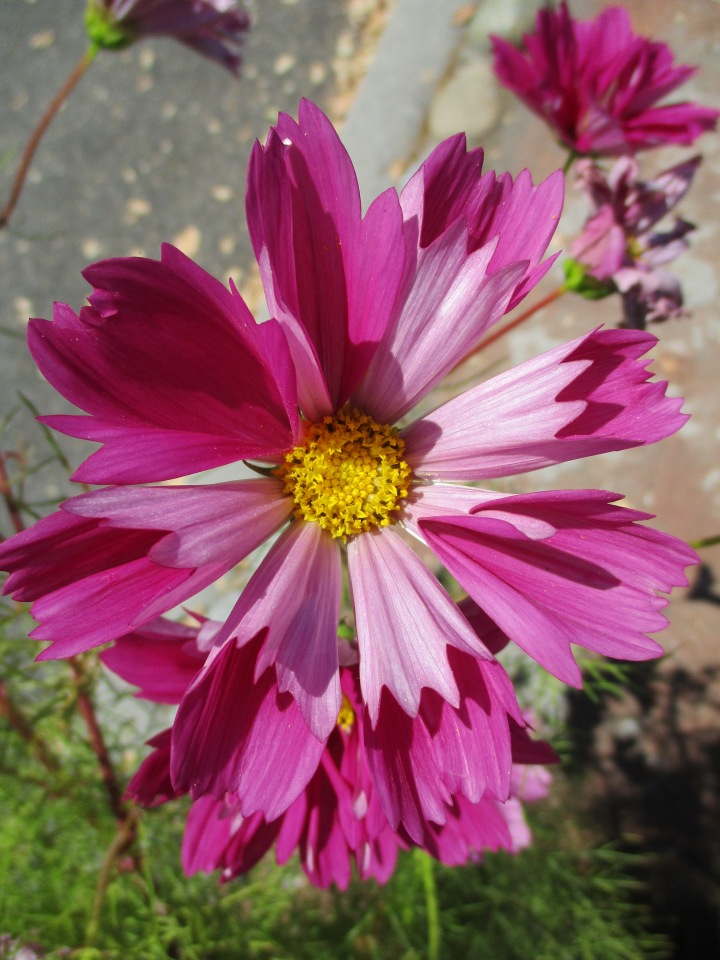 Their pastel hues and blends of pink, lavender, near red and white are so perfect for the middle of spring when cosmos, Cosmos bipinnatus, begin to bloom. They are just as perfect as bloom continues right through summer and almost to autumn, when the tall and airy plants finally begin to wear themselves out. If they continue through autumn, they eventually succumb to frost in winter.
Their pastel hues and blends of pink, lavender, near red and white are so perfect for the middle of spring when cosmos, Cosmos bipinnatus, begin to bloom. They are just as perfect as bloom continues right through summer and almost to autumn, when the tall and airy plants finally begin to wear themselves out. If they continue through autumn, they eventually succumb to frost in winter.
Individual flowers are as delicate as they look, but are prolific. New flowers replace older flowers a quickly as they fade. Deadheading promotes even better bloom. A few of the last flowers to bloom can be left as the season ends to sow seed for next year. However, fancy cultivars are not true to type, so subsequent generations will be more like the basic specie, with simpler flowers.
Cosmos likes full sun exposure, rich soil and regular watering. Mature plants are about two or three, or even four feet tall, although the most popular varieties stay shorter and more compact. The species name of ‘bipinnatus‘ refers to the pinnate leaves that are divided into very narrow lobes that are also divided into even narrower lobes. The collective foliage is very delicate, lacy and airy.
Cosmos always makes me think of Korea, they were flowering everywhere, along roadsides and every bit of spare land. A lovely sight
LikeLiked by 1 person
Well, at least there is a reason for that association. Red begonias remind me of Korea. I have never been there.
LikeLike
Red begonia???
LikeLike
Kim Jong-il liked them so much that he had his own bright red cultivar named after him. Begonias had always been a very popular flower in the Koreas anyway. I suppose I should not identify Kim Jong-il’s favorite flower with Korea, but I do.
LikeLiked by 1 person
I was in South Korea I have a Korean daughter in law
LikeLiked by 1 person
Of course. Most who go to Korea go to South Korea.
LikeLike
I love Cosmos, but I have never been able to get them to grow here.
LikeLiked by 1 person
I would not have guessed that there is someplace where they will not grow! They have a long season here of course, but they do not need to, since they are mere annuals. They do not mind harsh winters because they are not around when the weather gets cold.
LikeLiked by 1 person
Thanks to your post, I’ve learned that Cosmos parviflorus, or Southwestern cosmos, is our only native cosmos here in Texas. It’s limited to upper elevations of the Big Bend region: one more reason to head that direction some day.
LikeLiked by 1 person
It may take some serious hunting to find something with a name like parviflorus. Those flowers will not stand out like the common types grown in home gardens.
LikeLiked by 1 person
Carl Sagan once did a television series about a different sort of cosmos.
LikeLiked by 1 person
Well, yeah; that was quite . . . different.
LikeLike
I love their delicate look but they really do not like to be dry.
LikeLiked by 1 person
Yes, the really like to be watered while the weather is warm. However, they last surprisingly well if they stop getting watered as they slow down in autumn while the weather is cool. If they do not get cut down first, they survive until frost.
LikeLiked by 1 person
beautiful, can only grow as annuals here, but they do self seed!
LikeLiked by 1 person
They are annuals here too, but because their off season is so brief, they may not seem like it.
LikeLike